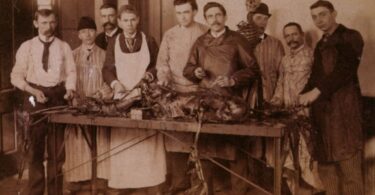A metaphor that explains the current situation of homeopathy
What would life be like in a two-dimensional world? And in a one-dimensional world? And in a world without any dimension? And, beyond the three dimensions, are there spaces for 4, 5, 10, or more dimensions? And, if they exist, can one connect to them?
Flatland, “A Romance of Many Dimensions”, is an extraordinary short novel published in 1884 by Edwin A. Abbott. It came out a few years after “Alice in Wonderland” (1865), a book by Lewis Carroll with which it shares some similarities in what has come to be called “mathematical fiction.”
Abbott, like Carroll, was also a mathematician, and in this book which is about many dimensions as indicated by the title, he demonstrates this richly by answering in a very ingenious way all those questions raised in the prologue.
Flatland is a two-dimensional world in which Mr. Square, the teller of the story, lives. In the first part (“this world”) he describes the society of Flatland. The lowest status is occupied by women (lines) because of their emotional and very irrational nature.
Then come the isosceles triangles (soldiers or workers), and then the equilaterals, squares and pentagons. From there, and as the number of sides increases, it goes up to the noble class until reaching the Circles which are the true masters of that world (priests) because they have so many sides that, in the end, they cannot be distinguished and resemble perfect circles.
It is a society in which the geometric configuration shapes the character. Therefore, the more sides you have and the more equal they are, the greater your virtues and merits. Irregular figures are mocked since childhood (beginning with their own parents). They are marginalized as deviant or criminals who must do therapy to be able to integrate into society, to increase the number of their sides and to equalize them; or they are eliminated directly.
This part is used by the author to make a caustic social satire. Abbott, ahead of his time, was in favor of the complete emancipation of women, with equal civil rights, for universal suffrage and popular democracy, positions that are most advanced even in our time.
But it is the second part (“other worlds”) where the novel and the author’s genius shines even more.
On the last day of the year 1999, the Square enters in his dreams, into a world in which there are only lines. He tries to explain to one of them, who turns out to be the king of Lineland, that, although his world is real, it is not the entire world. There are not only the north and the south, but also the right and the left, something that is impossible to conceive by the king of lines.
Returning to his two-dimensional world and disturbed by his dream, it is his little grandson who one day asks him, that, since it is possible to calculate the surface of the people (square side), what would the calculation of sides raised to a cube mean? (actually the volume). The Square puts him off, telling him that this is nonsense, but he can’t stop thinking about it.
On another night he notices a strange presence in his room. It is like a kind of circle (actually a Sphere) with which he talks (in several chapters) and who shows him what Spaceland is, the place where it comes from.
The Square, carried by the Sphere, is totally impressed to see Flatland from above. Now he can see it deep down as if he were a kind of God, something totally impossible in his two-dimensional world. The Sphere tells him that this vision is normal for all the inhabitants of Spaceland.
Then it comes that the Square imagines that there could also be a fourth dimension and imagines how a world called Thoughtland would be. He also visits Pointland where there seem none to exist… and speculates about other universes of many more dimensions.
A very advanced and modern story for the time, am I right?
Well, the end is already imaginable. Thinking that he has made one of the great discoveries of existence, he intends to explain all this to the conclave of Flatland. The wise Circles listen to him, but, of course, what happens? Yes, your guess is right. They imprisoned him for defying Flatland’s dogmas!
As in this novel, we humans also have several dimensions, the physical, emotional and spiritual. These three, at a minimum, are real, and have or manifest their effects. That science can only measure one or one and a half of them should not make us believe that the others do not exist, as the Flatlanders believe that theirs are the only ones.
Homeopathy also points to these other dimensions of the person and integrates and connects them. These other realities we all experience in ourselves without the need for further studies. Moreover, we do it from a medical system, adapting those constructs that we have called science and which is as real (or unreal) as any other. We adapt to the present and predominant science, because, as a good construct as that it is, it is not objective, as some want to make us believe. They change over time, and depend on the interests of industry as is known.
The Conclave of Flatland, with a good “priestly” representation of all kinds, strives to call everything a “pseudoscience” that they don‘t understand or that does not conform to their (historically changing) dogmas. Many others look and remain silent because they find it far beyond them. Do you remember the saying “first they came for the communists but I didn’t speak because I wasn’t a communist …” ?
That‘s why the persecution of homeopathy is not only a “homeopathic” issue. It is something broader, that concerns a way of understanding science and reality.
That‘s why the Square teaches us beautifully not to be fanatics of anything, but to question, and even to be skeptical of our skepticism, because the real truth is surely far from our reach.
“… It is part of the martyrdom which I endure for the cause of the Truth that there are seasons of mental weakness, when Cubes and Spheres flit away into the background of scarce-possible existences; when the Land of Three Dimensions seems almost as visionary as the Land of One or None; nay, when even this hard wall that bars me from my freedom, these very tablets on which I am writing, and all the substantial realities of Flatland itself, appear no better than the offspring of a diseased imagination, or the baseless fabric of a dream.”
Yes, the doubt, that damn doubt that belongs to the true scientists. That, which moves us away from being blind followers and makes us a little more free.
Here you can download the novel :
https://ned.ipac.caltech.edu/level5/Abbott/paper.pdf
Gonzalo Fernandez-Quiroga
La Homeopatía en un lugar llamado Planilandia
Una metáfora que explica la situación actual de la Homeopatía
¿Cómo sería la existencia en un mundo de dos dimensiones? ¿y de una sola? ¿y de ninguna dimensión? Y, por encima de las tres dimensiones ¿existen espacios de 4, 5, 10, o más dimensiones? Y, si existen, ¿se puede conectar con ellos?
Planilandia (Flatland), “una novela de muchas dimensiones”, es una extraordinaria novela corta publicada en 1884 por Edwin A. Abbot pocos años después de “Alicia en el País de las maravillas” (1865) libro con el que comparte algunas similitudes en lo que se ha venido en llamar “ficción matemática”.
Abbot, como Carroll, era también matemático y en este libro, que es muchas cosas (como indica el subtítulo), lo demuestra con creces respondiendo de forma harto ingeniosa a todas esas preguntas que se plantean en el prólogo.
Planilandia es un mundo de dos dimensiones en el que vive el Sr. Cuadrado que es el narrador de la historia.
En la primera parte (“este mundo”) se nos describe la sociedad Planilandesa. El estado más bajo lo ocupan las mujeres (líneas) por su naturaleza emotiva y muy poco racional. Después los triángulos isósceles (soldados u obreros), y después los equiláteros, cuadrados y pentágonos. A partir de ahí, y a medida que aumentan los lados, se va subiendo en la clase noble hasta llegar alos Círculos que son los verdaderos amos de ese mundo (sacerdotes) ya que tienen tantos lados que, al final, no pueden distinguirse y semejan eso, círculos perfectos.
Se trata de una sociedad en que la configuración geométrica configura el carácter. Por ello, cuantos más lados tengas y más iguales, mayores virtudes y méritos. Las figuras irregulares son objeto de burla ya desde pequeños (empezando por sus propios padres) y son individuos marginados, desviados o criminales que deben hacer terapia para poder integrarse en la sociedad (aumentando sus lados e igualándolos) o son directamente eliminados.
Esta parte es aprovechada por el autor para hacer una corrosiva sátira social. Abbot, adelantado a su tiempo, era favorable a la completa emancipación de la mujer, a una igualdad de derechos cívicos, al sufragio universal y a la democracia popular, posiciones de lo más avanzado aún en nuestra época.
Pero es la segunda parte (“otros mundos”) donde brilla aún más la novela y el genio del autor.
El último día del año 1999 el Cuadrado entra en sueños en un mundo en el que sólo existen líneas y le intenta explicar a una de ellas que resulta ser el rey de Linealandia, que cómo a pesar de que su mundo es real, no es todo el mundo. Que no sólo existe el norte y sur sino la derecha y la izquierda, algo que es imposible de concebir para el rey de las líneas.
Vuelto a su mundo de dos dimensiones y perturbado por su sueño, es su nieto pequeño el que un día le pregunta que ya que se puede calcular la superficie de las personas (lado al cuadrado) ¿qué significaría la operación de lado elevado al cubo? (en realidad el volumen). El Cuadrado se lo saca de encima diciéndole que eso es una tontería pero no puede dejar de pensar en ello.
Y otra noche nota una extraña presencia en su habitación, es como una especie de círculo (en realidad una Esfera) con la que dialoga en varios capítulos y que le enseña lo que es Espaciolandia, el lugar de donde proviene.
El Cuadrado, llevado por la Esfera, queda totalmente impresionado al poder ver Planilandia desde arriba, ahora la puede ver en su interior como si él fuera una especie de dios, algo totalmente imposible en su mundo de dos dimensiones. Y ¡qué maravilla! por mucho que la Esfera le diga que esa visión es la normal en todos los habitantes de Espaciolandia.
Es así entonces como el Cuadrado imagina que también debería existir una cuarta dimensión y se imagina como será ese mundo que denomina Pensamientolandia. Y también visita Puntolandia donde no parece existir ninguna… y especula con otros universos de muchas más dimensiones.
Todo muy adelantado y moderno para la época ¿verdad?
Pues el final ya es imaginable. Pensando que ha hecho uno de los grandes descubrimientos de la existencia intenta explicar todo esto al cónclave de Planilandia. Los sabios Círculos le escuchan pero, claro está, ¿qué es lo que sucede? Sí, habéis acertado, ¡lo encarcelan por desafiar los dogmas dePlanilandia!
Como en esta novela, el ser humano, las personas tenemos varias dimensiones. La física, la emocional y la espiritual o como quieran llamarla. Las tres, como mínimo, son reales o tienen o manifiestan sus efectos. Que un artefacto necesario como la ciencia sólo pueda medir una o una y media de ellas no nos debe hacer pensar que las otras no existen, aunque a los planilandeses les parezca que esa es la única.
Lo que hace la homeopatía es apuntar también a esas otras dimensiones de la persona, integrarlas y conectarlas. Esas otras realidades de las que todos tenemos experiencia en nosotros mismos sin necesidad de mayores estudios. Y además lo hace desde un sistema médico adaptándose con mejor o peor fortuna a los requisitos de ese constructo que hemos llamado ciencia y que es tan real (o irreal) como cualquier otro. Los requisitos, por cierto, de la ciencia actual y predominante porque, como buen constructo que es, hecho por hombres, no es aséptica ni objetiva como algunos pretenden hacernos creer, sino que van cambiando con el tiempo. Y eso sin contar otros intereses de la industria que todos conocemos.
El Cónclave de Planilandia, donde hay una buena representación “sacerdotal” de todo tipo, y con honrosas excepciones, se empeña en tachar de “pseudociencia” todo aquello que no entiende o que no se ajusta a sus (cambiantes históricamente) dogmas. Muchos otros miran y callan porque les parece que no va con ellos. Pero ¡ay! recuerden lo de “primero vinieron a buscar a los comunistas pero yo no hablé porque no era comunista…”
Por eso en estos tiempos no se dirime sólo una cuestión “homeopática”. Es algo más amplio que atañe a una forma de entender la ciencia y la realidad.
Y por eso el Cuadrado también nos muestra, en su última y creo más bonita enseñanza, a no ser fanáticos de nada, a ser escépticos hasta de nuestro escepticismo, a dudar en suma. Porque la verdad verdadera seguramente está muy lejos de nuestro alcance.
Ese es, entre rejas, su lamento final cargado de inteligencia, de verdad y humanidad.
“…forma parte de mi Martirio, y lo soporto por la causa de la Verdad, el sufrir periodos de flaqueza mental en cuyo curso los Cubos y las esferas se desvanecen para mi en las profundidades de las existencias apenas posibles; entonces, la Tierra de las Tres Dimensiones, me parece casi tan visionaria como la Tierra del Uno o del Ninguno. Es más, entonces esta dura pared que me separa de la libertad, estas mismas tabletas en las que escribo, y todas las realidades sustanciales de la misma Planilandia, no me parecen nada mas que el fruto de una imaginación enferma, o la construcción ilusoria de un sueño”.
Sí, la duda, esa maldita duda que es propia de los verdaderos científicos. La que nos aleja del rebaño, de cualquier rebaño, y nos hace un poco más libres.







highly inspiring.for regulators to read between lines.